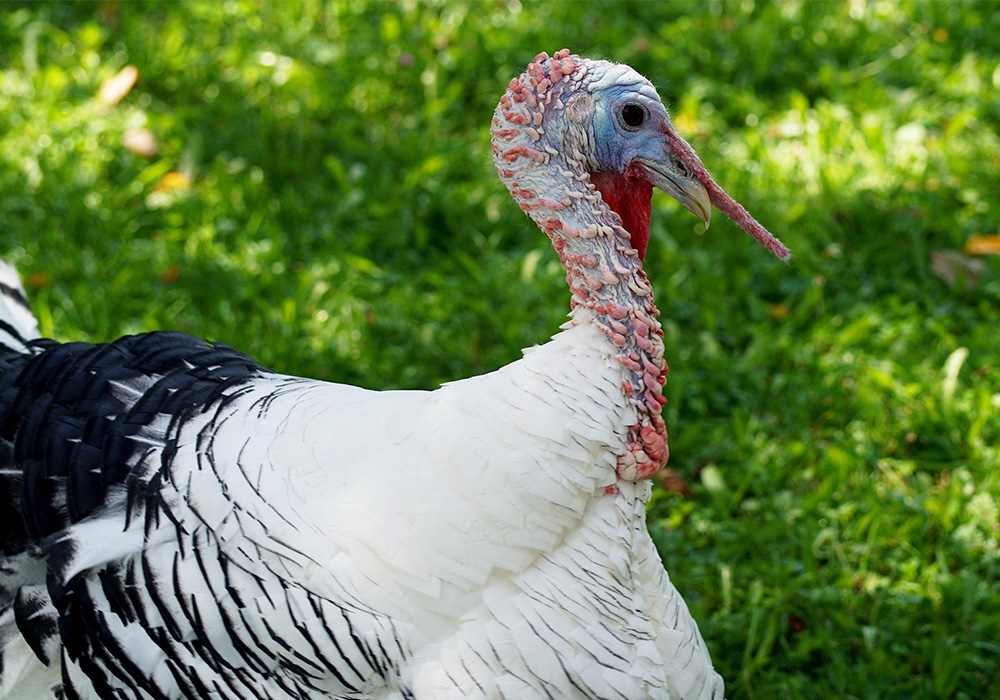
Turkey - is the largest agricultural bird, it is breed only for meat production. Modern crosses reach a high body weight. Males weigh 30 kg (individuals 40 kg), while females weigh 11.5 kg, meat-breed males weigh 20 kg at the age 16-17 weeks, while females weigh 10 kg. Edible parts in turkey meat are 70% and more, while muscle tissue is more than 60%. Turkey meat is distinguished by high taste, dietary, culinary and nutritional value. They contain up to 28% protein, in moderate amounts - 2-5% fat, rich in B group vitamins. Their meat is characterized by the lowest cholesterol content compared to other birds. With multiple staffing of the parent team, one average female gives 200 eggs and more than 1,500 kg of meat per year.
It is known that the most important protein in human nutrition, the deficit of which is 50% in the world. Scientific calculations show that the most protein per hectare is provided by turkey meat and milk production (144 kg), followed by eggs and broilers 138 and 137 kg of protein, bacon provides only 80 kg, beef and lamb, respectively, 35 and 32 kg.
Turkey laying ability is 70-100 eggs, fertilization is 80-90%, hatching is 80-85%, the average weight of a turkey egg is 80-90 g (may range from 70 to 100 g), the incubation period is 28 days. The average weight of a one-day-old poult is 60 g. Meat productivity of turkey is characterized by rapid development of muscle tissue at an early age, especially with high nutritional properties of breast and meat. Turkey has the highest protein content in muscle tissue among other species of birds: protein in the muscles of the breast is 25%, leg - 20% and more.
The average duration of turkey growing up is 12-17 weeks. Modern hybrids reach 3-5 kg live weight at the age 12 weeks with optimal storage conditions and complete nutrition. Food consumption for per 1 kg for live weight doesn’t exceed 3 kg. The slaughter mass of turkey is 89%, the mass of half-slaughtered slaughter is 80-84%. The turkey carcass consists of: From muscle tissue - 50%, skin with subcutaneous fat 10-15, internal fat - 5-15; Bone - 20%. The excretory deficiency of some modern cross-breeds (hybrid) is 65%. It should be noted that the formation of meat traits occurs for the female turkey at an earlier age than for the male turkey. So for example, by the age of 12-13 weeks they have already developed meaty traits. At the same age, females show the best quality, tenderness and taste of meat, while male turkeys reach good fattening, high quality meat a little later – at the age of 17 weeks. With increasing age and fattening, the fat content of its meat increases (up to 30%), while the protein decreases to 18%. Turkey fat is characterized by good quality indicators: melting point 31-32ºC, iodine number - 65-80, lathering point - 190-225.
Turkey muscle tissue, like chicken, is characterized by coloration, chemical composition and organoleptic properties. The turkey white meat is high in protein, essential amino acids and low in fat. Red meat, by contrast, contains large amounts of fat and less protein (see table).

The largest portion of turkey meat is white meat, which (like red meat) has a special taste, which is typical for wild poultry. This specific taste and smell of turkey meat is due to its high content of unsaturated fatty acids.
One of the most important factors in the production of turkey meat is the length of their storage before slaughter. Numerous experiments have shown that the most optimal period for slaughtering of a turkey is: For light cross - 12 weeks, for medium cross - 17 weeks. For modern light crosses, the growth period is reduced to 8-9 weeks. Currently, three types of turkeys are used to breed turkey for meat production: light cross, medium and heavy, which are characterized by the following data:

Mini, medium and maxi-turkey are very popular in America. The average live weight of a Maxi-turkey at the age of 18 weeks is 8 kg. Consumption of food per 1 kg of body weight - 3 kg. Maximum live weight of Maxi-turkey: 30-35 kg for males and 10-12 kg for females. Turkeys have pronounced sexual dimorphism. Males are 25-40% larger than females at the age 17 weeks.
Based on the white North Caucasian variety, turkey lines and crosses are created. For example, turkey mating cross B-32 at the age of 12-13 weeks: females weigh 3.0 kg, males - 4 kg.
Consumption of food per 1 kg of body weight is 3 kg. The English cross "New Trill 5" is of special value. This turkey cross is characterized by the following productivity:

Cross `New Trill 5 ~ is characterized by good meat characteristics and meat quality. Slaughter mass is 89-91%, breast muscle mass output from slaughter mass is 17-20%. In order to improve the quality of turkey meat, amputation of the wings in the elbow joint at the age 1-3 days is considered to be a highly effective method.
Amputation of turkey-broiler wings increases breast muscle tissue by 3%. The commodity properties of the winged turkey-broiler slaughter are also increasing.
Turkey-breeding is developing at a very fast pace in the world. By 2003, the world had produced 5.25 million tons, while the US had produced 3 million tons of turkey meat. Currently turkey meat accounts for 10-12% of the total balance of poultry meat. The largest producer of turkey meat is the USA. So for example, in North Carolina there is a turkey meat processing plant that slaughters 85,000 turkeys a day and puts 60 species of products under a trade name with 400 names. It exports 460 tons of turkey meat per week.